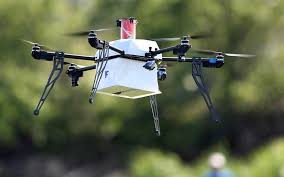In Kenya, drones are now playing a big role in delivering medicines, vaccines, and other health supplies to people in rural areas. These drones fly directly from a base to health centres that are hard to reach by road. It is a new way of solving delivery problems in many communities.
This delivery service started in 2023 when Zipline, a US-based delivery company, opened a base in Chemelil, Kisumu County. From this base, the drones fly to health facilities in Kisumu, Homa Bay, Nyamira, and Kericho counties. The drones cut delivery time from hours by road to minutes by air. Instead of health workers waiting all day or more for vaccines or medicines, the delivery now reaches them quickly.
At St Joseph’s Nyabondo Mission Hospital, a health worker explained that a delivery that normally would take a vehicle hours due to poor roads now arrives in minutes by drone. The President of Kenya, William Ruto, was present during the launch in Chemelil and saw first-hand how much faster the service made delivery of health products.
The health manager at the hospital said more than 10,000 deliveries have already been made to health facilities in Kisumu and nearby counties. Nearly 40 percent of these deliveries were for urgent health products, like vaccines, HIV test kits, and rabies vaccines. Drones have made it much easier for health workers to respond quickly when there are emergencies or vaccines are about to expire.
This service has teamed up with the Elton John AIDS Foundation to send HIV-related drugs and vaccines to communities in Kisumu and Western Kenya. It has also delivered rabies vaccines and other health products to Bungoma and nearby areas. The technology lets health workers stay in their facilities instead of making dangerous journeys on bad roads.
Nurses like Florence Aketch from Kisumu say the service has made a huge difference in their ability to care for their patients. She explained that vaccines or medication sometimes expire if delivery is delayed, and many children miss vaccines due to poor delivery. With drones, health workers now get their vaccines quickly and safely.
Studies from other countries show the power of this technology. Rwanda started using drones for delivering blood in 2016 and was able to cut waste by 67 percent and delivery time by 61 percent. Ghana has delivered more than 1.4 million vaccines by drone. The success in Kenya signals a future where many more people in hard-to-reach areas will have faster and cheaper health care.
In Kenya, there are some obstacles to scaling this service. Local authorities need to approve operations, and companies must follow the Kenya Civil Aviation Authority (KCAA) Regulations of 2020. There is a need to train more local pilots and build proper infrastructure, like landing pads and maintenance stations.
Support from the government is growing. Import duties on drones have been removed, and partnerships between companies like Zipline, Siemens-Wingcopter-Healthineers, and Kenya Flying Labs are helping to bring this service to more counties, including Turkana and Tharaka Nithi. The aim is to connect health facilities in hard-to-reach areas — called “blood deserts”— to a reliable delivery network.
Drones cut delivery emissions by over 90 percent when we compare their delivery to road transport. They also cut waste by delivering vaccines quickly and safely. Furthermore, these operations employ locals — all the workers at the Kisumu base are Kenyans — adding a boost to employment.
As this service expands, it will help more people in Kenya get health care on time, regardless of where they live. Public-private partnerships, proper training, and policy support will be key to making sure the service reaches all communities.
Kenya’s use of drones for health delivery shows how technology can solve health care problems. The country is already seeing the benefits — faster delivery, less waste, and more people getting vaccines and medicines on time. It is a powerful way forward for universal health care and a future where everyone has a fair chance to be healthy.
